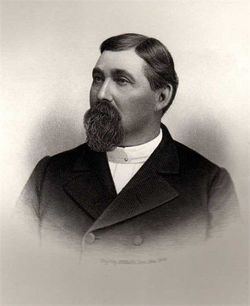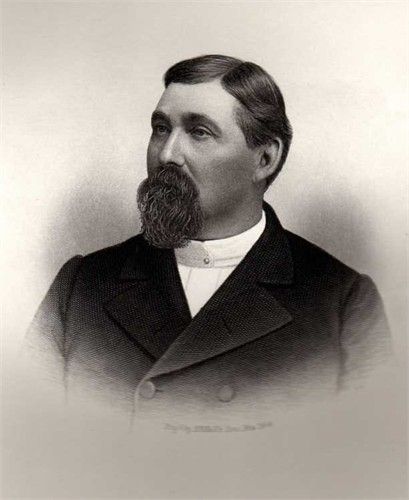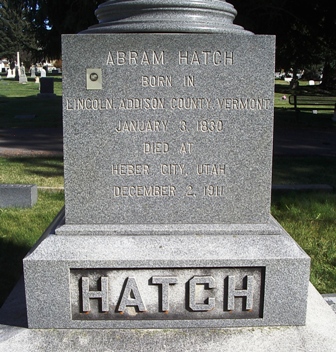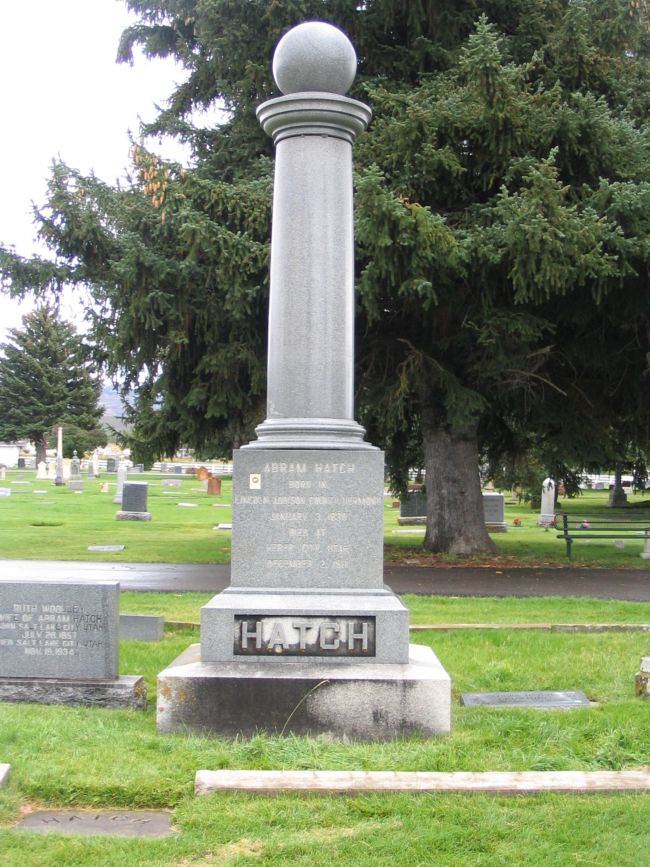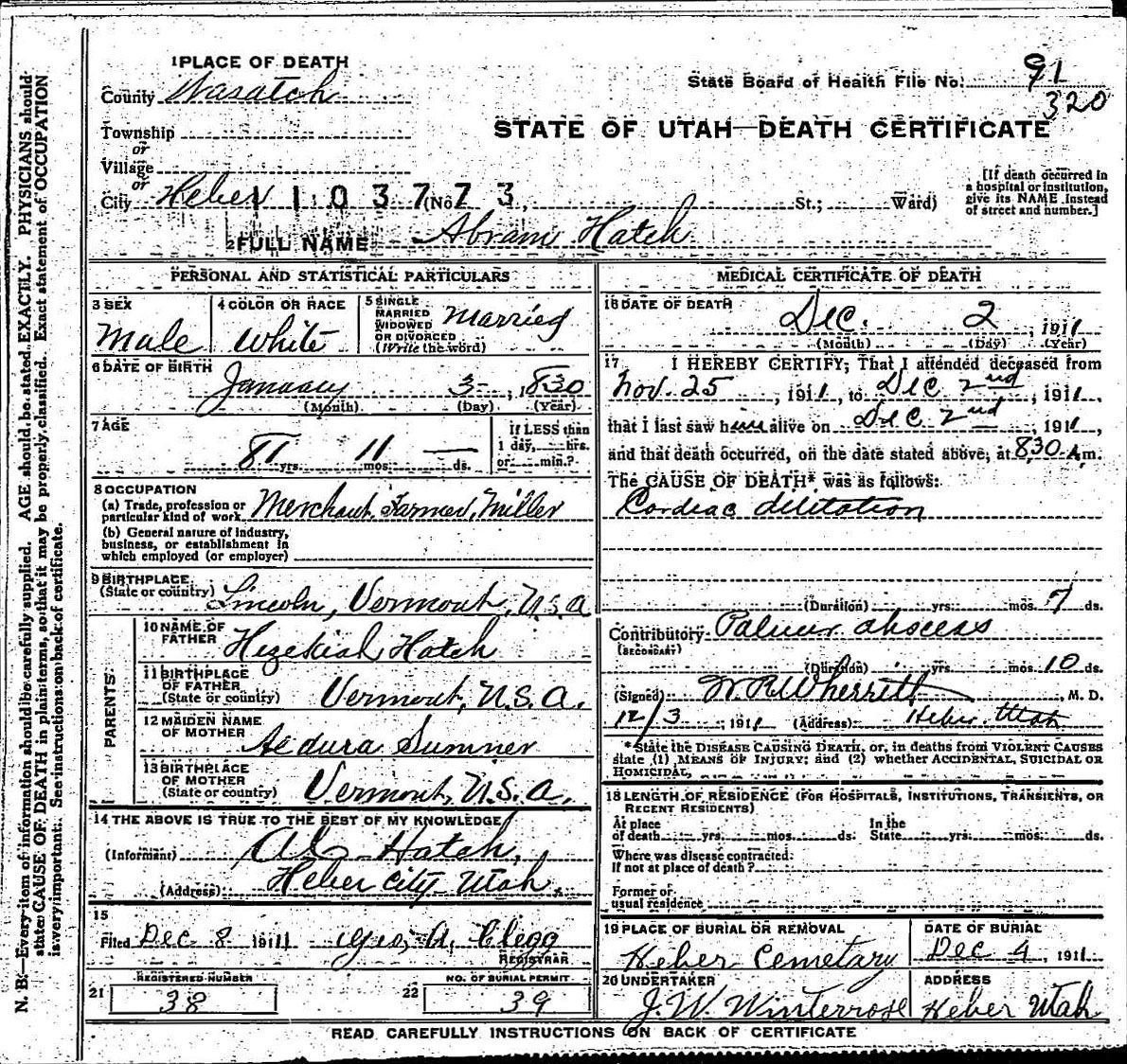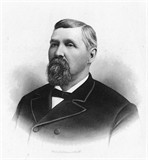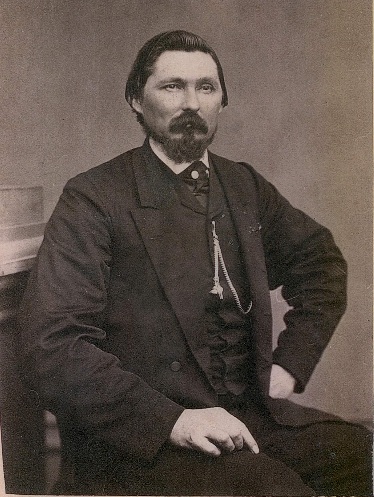Abram Hatch, son of Hezekiah and Aldura Sumner Hatch, was born January 3, 1830, at Lincoln, Addison county, Vermont. He was educated in the common schools of Lincoln and Bristol until about ten years of age, when he moved to Nauvoo, Illinois, the headquarters of the Latter-day Saints. This was in the fall of 1840. Early in that year his father's family and some of their immediate connections had been converted to Mormonism through the preaching of Elder Peltiah Brown. Abram's mother died in the spring, and about six months later the family removed to Nauvoo. Hezekiah Hatch was a wealthy farmer in Vermont, and withal a man of education. He bought property in Nauvoo, built a fine brick house there, and opened a farm on the adjoining prairie. He died in 1841. After that Abram lived with his grandfather. His uncle Jeremiah came from North Carolina to administer the estate. At the death of the Prophet and the succession of President Young to the leadership of the Church, this uncle became an adherent of Sidney Rigdon's, married one of his daughters, and was one of his apostles; but the rest of the family, including Abram, his brothers, and the old Revolutionary grandsire, followed the fortunes of the main body of the Saints.
During the mob depredations around Nauvoo, instituted for the purpose of compelling the Mormon people to leave the State, Abram Hatch was with the posse of three hundred men who made a tour of Hancock county in company with Sheriff Backenstos, to arrest the leaders of the mob. In the exodus that followed he drove a team in the first company that moved west from the rendezvous on Sugar Creek, after the passage of the Mississippi. From Garden Grove he returned with others to Nauvoo for provisions. He found letters awaiting him there from his uncle Jeremiah, urging him to come to Greencastle, Pennsylvania, and complete his education. This had been the dream of his life, and he forthwith set out for that place. On arriving there, he found that his uncle had overrated his ability to send him to college. Though deeply disappointed he did not despair, but immediately sought and found practical employment first in Ebenezer Robinson's printing office, where the Latter-day Saints' Herald was published in the interest of Elder Rigdon's church, and afterwards with a merchant named Newton, a member of that body. While at Greencastle, Abram saw the entire failure of the Rigdonite movement. His employer's business having collapsed, he next sought to enlist as a soldier for the Mexican war, which was then in progress. He was rejected by the recruiting officers at Chambersburg on account of his youth and immature size, being only seventeen years old. He also tried to enter Girard college, but not being a native of Pennsylvania, was unsuccessful. Thwarted in his aspirations for a collegiate education, he again turned to the west, resolving in all the enthusiasm and buoyancy of youth, to push earnestly into practical life, leaving his further education to general experience under the dispensations of providence.
At Pittsburg he found employment in a boat store and bakery, and soon afterwards secured a situation as cook on a coal boat plying between that point and New Orleans, a distance of two thousand miles. Returning from a successful voyage, he took his former situation at advanced wages, and shortly afterwards made two or three trips as cabin boy on a steamboat running between Pittsburg and Cincinnati. After being employed upon the rivers for some time, he proceeded to rejoin his brother Jeremiah, who was living on Sugar Creek, in Iowa. In the fall of that year—1847—he went with his brother and family to Florence, Nebraska, then called Winter Quarters, to which point President Young and many of the Pioneers had just returned after planting a colony in Salt Lake valley. Electrified by the accounts they gave of their journey and the country they had seen, Abram resolved to emigrate to the Rocky mountains and establish a home for himself in the midst of his people. With this end in view he went to St. Louis in the summer of 1848 and followed steamboating on the rivers, part of the time as cabin boy and subsequently as deck hand, carefully saving his wages to purchase a suitable outfit with which to cross the plains. The following year he spent at St. Joseph, Missouri, accumulating means for the same purpose. It was in the spring of 1850 that he, with his brothers Jeremiah and Lorenzo, his sisters Adeline and Elizabeth, with others, crossed the Missouri river on fiat boats and began their journey westward. The captain of their company was David Evans. Abram drove his own team. His outfit consisted of one wagon, two yoke of oxen, two yoke of cows, farming tools, clothing and a year's provisions. He took great delight in hunting, and assisted in killing buffalo to supply food for the train. On the 15th of September they entered Salt Lake valley. He and his brothers remained at Salt Lake City during the fall and winter, but in the spring of 1851 moved to Utah county, where Abram and Lorenzo assisted in building and were part owners of the first grist mill erected in the northern part of that county. On the 22nd of September, 1852, Abram Hatch married Permelia Jane Lott, Bishop Isaac Houston performing the ceremony. He settled at Lehi and engaged in farming, merchandizing and trading. He also kept a hotel. In 1861 and 1863 he crossed and re-crossed the plains for the purpose of bringing emigrants to Utah and freighting merchandise for his store. In all, he traversed the plains eleven times as missionary, merchant and traveler.
In the spring of 1864 Mr. Hatch was called to fulfill a three years mission to Europe. Leaving his business affairs in charge of his wife, he set out about the last of June with President Daniel H. Wells and Apostle Brigham Young, Jr., who, with their wives—Mrs. Hannah C. Wells and Mrs. Catherine C. Young—were also en route for Europe. The wagon train they traveled in was commanded by Captain John R. Murdock. By way of Chicago and Niagara Falls, Mr. Hatch reached New York, and sailed thence on an Anchor line steamer for Glasgow, where he landed and proceeded to Liverpool. He was appointed by the President of the European Mission, George Q. Cannon, to labor in the Birmingham conference under the presidency of Elder William H. Sherman, who tenderly nursed him through an attack of smallpox during his ministry in that conference. His traveling companion was Elder Francis Platt. At a general council in December, at which were present Daniel H. Wells, then President of the Mission, Orson Pratt, Brigham Young, Jr., William B. Preston, Moses Thatcher, and other notable Elders, he was appointed president of the Manchester district, including Liverpool, Preston and the Isle of Man. He was subsequently appointed to the Birmingham pastorate, including the Warwickshire, Staffordshire and Birmingham conferences. His health failing, he took a tour on the continent, visiting the principal cities of France, Switzerland and Holland. Returning to Great Britain, he completed his mission, from which he was released in December, 1866. Prior to his departure for home, he visited various points of interest in the British Isles, and in company with Heber John Richards and William W. Riter, passed over into Ireland. The Fenian excitement was then at its height, and on landing at Dublin, Elder Hatch, to his amazement, was arrested and conducted to the guard house on suspicion of being Stevens, the chief of the conspirators. He soon succeeded in convincing the officers that it was a case of mistaken identity, and was set at liberty. On emerging from the guard house, he and his friends were surrounded by a mob, shouting and yelling (for the people still supposed Hatch to be Stephens), and it required the assistance of a force of police to enable the three Elders to make their way through the dense and agitated crowd to their hotel. After two days in Ireland, they gladly returned to Liverpool. It was on March 26, 1867, that Mr. Hatch set sail from that port, homeward bound. He took passage on the "Great Eastern," and had as fellow-passengers to New York such notables as Cyrus W. Field, of Atlantic cable fame, Paul Du Challieu, the African traveler and explorer, and Jules Verne, the French author, who in his "Floating City," afterwards published, made very favorable mention of "Mr. Hatch the Elder." whose announcement to lecture on Mormonism in the ship's saloon was cancelled "as the wives of the Puritans on board did not approve of their husbands becoming acquainted with the mysteries of Mormonism." Several interviews upon that subject, however, took place between Elder Hatch and Mr. Field, and this, too, at the latter's own seeking. He seemed greatly interested in what he heard. An accident occurred at the very beginning of the voyage, in which four sailors were killed and twelve others wounded. It occurred while raising the anchor with a steam engine, the catch breaking with fatal results. Another incident of the voyage was a terrible storm, followed by a burial at sea, the dead man being a sailor, the captain's nephew, who died from injuries received during the tempest.
At New York, where he landed in April, Mr. Hatch tarried several weeks, acting as Church advance agent (according to a request made of him at Liverpool by Brigham Young, Jr., President of the European Mission) and purchasing goods for his Utah store. He visited his relatives in Vermont, erected a marble tombstone over his mother's grave at Lincoln, and also visited Sidney Rigdon and family at Friendship, Western New York. During his interview with the once famous leader, whom he describes as a "grand looking old man, large and portly," who impressed him with his "intellectual importance;" Mr. Hatch said, "Elder Rigdon, it is reputed that you wrote the Book of Mormon; did you or did you not? What is your testimony—your dying testimony?" The answer came without hesitation, "I did not write the Book of Mormon. It is the revelations of Jesus Christ." Mr. Rigdon still felt bad towards President Young, whom he accused of supplanting him and by his shrewdness depriving him of his rights as the lawful successor to Joseph Smith. Mr. Hatch regarded Rigdon as "an intellectual giant of a certain type," as "a man of extraordinary spiritual aspirations," yet "lacking in the elements of a great leader." Mr. Hatch arrived home in August, and in a few weeks was called by President Young to go to Wasatch county and act as a Presiding Bishop in that section. At this time he was a member of the 44th quorum of Seventies. President Young ordained him a High Priest, and set him apart for his Bishopric December 2, 1867. He had previously removed to his new home in Heber City, where he devoted himself to the task of building up the town and county. He was for six years probate judge of Wasatch county, and for twenty-three years continuously represented the county in the territorial legislature. In 1877, when the stakes of Zion were organized, Bishop Hatch was made President of Wasatch stake. He continued in the mercantile business and organized a co-operative store, the business of which has constantly increased. His two oldest sons are associated with him in merchandizing and stock raising. In addition to his other public duties, he has performed military service, leading a company of cavalry to the relief of the Salmon river settlement late in the fifties.
In November, 1880, President Hatch was called upon to mourn the loss of his wife, who died after a lingering illness of four months, and was buried in the cemetery at Lehi beside their two sons, Rodolph and John, who died while their father was in England. In addition to these, she had borne him five children, namely, Joseph, the eldest, superintendent of the co-operative store; Abram C., who has charge of the horse and cattle herds; Minnie A., who is married to Captain Pardon Dodds, of Ashley valley; Emma Jane and Lucy Ann. In April, 1882, President Hatch married Miss Ruth Woolley, daughter of the late Bishop Edwin D. Wolley, of Salt Lake City. By her he has had four children—John, Mary Ann, Fanny La Prele and Edwin D. In 1883 Mr. Hatch made a trip to Washington, D.C., for the purpose of getting a claim allowed by the government. In this he was successful. While there he attended a reception given by President Arthur, and to which he was accompanied by Mrs. Belva A. Lockwood, Washington's lady lawyer. He also formed the acquaintance of Senator Edmunds, Secretary Teller, Major Powell and other notable men. In 1885 he attended the St. Louis cattle convention, and by request officiated as chaplain. He was accompanied by his wife and by Judge Woolley and wife, of Washington county, Utah. After getting through with the business and festivities of the occasion, the party took train for Memphis, and from there floated down to New Orleans on a palace steamer to attend the Southern and Central American Exposition. Mr. Hatch is a natural humorist and is noted for his genial disposition. He has a happy home, which is always open to his friends. He is benevolent and charitable, and has ever been greatly interested in education. As a member of the Utah Legislature he brought in the bill setting apart a portion of the public revenue for the benefit of the common schools. He was also the member who first moved the passage of the woman suffrage act, afterwards repealed by the Edmunds law. He remained President of Wasatch Stake until 1901, when, on account of failing health, he was honorably released from his long and faithful service in that capacity.
________________________
Name: Abram Hatch
Gender: male
Birth Date: 03 Jan 1830
Birth Place: Lincoln, Addison Co, UT
Parent1: Hezekiah Hatch
Parent2: Aldura Sumner
Spouse: Permelia Jane Lott; Ruth Wooley
Marriage Date: 02 Dec 1852;26 Apr 1882
Marriage Place: Lehi, Utah Co, UT;Salt Lake City, UT
Departure Date: Mar 1846;(early) 1850;15 Jun 1850
Departure Place: Sugar Creek IA (Nauvoo);St Joseph, MO;Sarph's Point, NE
Travel Company: from Sarpy's Point:
Brother and sisterr-in-law:
Jeremiah (27);
Louisa (25);
2 nieces,
Phoebe (3);
Aldura (2);
Brother, Lorenzo Hill (24);
2 Sisters:
Adeline (16);
Elizabeth (13).
Party: David Evans
Trail: Mormon to SLC
Arrival Date: 15 Sep 1850
Arrival Place: SLC via Parleys Canyon
Religion: LDS
Place Settled: Lehi in spring of 1851: Heber City in autumn of 1867.
Occupation: freighter, store owner, farmer, rancher, stake pres, legislator, community developer
Death Date: 02 Dec 1911
Death Place: Heber City, wasatch Co, UT
Burial Date: Dec 1911
Burial Place: Heber City Cem
Sources: Tullidge's Histories of Utah (V. II) Northern Utah, 1889 pp 186-203;whitney History of Utah (v. 2) 1893, pp f22, 24, 301-302;Hatch Family History, 1910, Ruth Hatch Hales.
Abram Hatch, son of Hezekiah and Aldura Sumner Hatch, was born January 3, 1830, at Lincoln, Addison county, Vermont. He was educated in the common schools of Lincoln and Bristol until about ten years of age, when he moved to Nauvoo, Illinois, the headquarters of the Latter-day Saints. This was in the fall of 1840. Early in that year his father's family and some of their immediate connections had been converted to Mormonism through the preaching of Elder Peltiah Brown. Abram's mother died in the spring, and about six months later the family removed to Nauvoo. Hezekiah Hatch was a wealthy farmer in Vermont, and withal a man of education. He bought property in Nauvoo, built a fine brick house there, and opened a farm on the adjoining prairie. He died in 1841. After that Abram lived with his grandfather. His uncle Jeremiah came from North Carolina to administer the estate. At the death of the Prophet and the succession of President Young to the leadership of the Church, this uncle became an adherent of Sidney Rigdon's, married one of his daughters, and was one of his apostles; but the rest of the family, including Abram, his brothers, and the old Revolutionary grandsire, followed the fortunes of the main body of the Saints.
During the mob depredations around Nauvoo, instituted for the purpose of compelling the Mormon people to leave the State, Abram Hatch was with the posse of three hundred men who made a tour of Hancock county in company with Sheriff Backenstos, to arrest the leaders of the mob. In the exodus that followed he drove a team in the first company that moved west from the rendezvous on Sugar Creek, after the passage of the Mississippi. From Garden Grove he returned with others to Nauvoo for provisions. He found letters awaiting him there from his uncle Jeremiah, urging him to come to Greencastle, Pennsylvania, and complete his education. This had been the dream of his life, and he forthwith set out for that place. On arriving there, he found that his uncle had overrated his ability to send him to college. Though deeply disappointed he did not despair, but immediately sought and found practical employment first in Ebenezer Robinson's printing office, where the Latter-day Saints' Herald was published in the interest of Elder Rigdon's church, and afterwards with a merchant named Newton, a member of that body. While at Greencastle, Abram saw the entire failure of the Rigdonite movement. His employer's business having collapsed, he next sought to enlist as a soldier for the Mexican war, which was then in progress. He was rejected by the recruiting officers at Chambersburg on account of his youth and immature size, being only seventeen years old. He also tried to enter Girard college, but not being a native of Pennsylvania, was unsuccessful. Thwarted in his aspirations for a collegiate education, he again turned to the west, resolving in all the enthusiasm and buoyancy of youth, to push earnestly into practical life, leaving his further education to general experience under the dispensations of providence.
At Pittsburg he found employment in a boat store and bakery, and soon afterwards secured a situation as cook on a coal boat plying between that point and New Orleans, a distance of two thousand miles. Returning from a successful voyage, he took his former situation at advanced wages, and shortly afterwards made two or three trips as cabin boy on a steamboat running between Pittsburg and Cincinnati. After being employed upon the rivers for some time, he proceeded to rejoin his brother Jeremiah, who was living on Sugar Creek, in Iowa. In the fall of that year—1847—he went with his brother and family to Florence, Nebraska, then called Winter Quarters, to which point President Young and many of the Pioneers had just returned after planting a colony in Salt Lake valley. Electrified by the accounts they gave of their journey and the country they had seen, Abram resolved to emigrate to the Rocky mountains and establish a home for himself in the midst of his people. With this end in view he went to St. Louis in the summer of 1848 and followed steamboating on the rivers, part of the time as cabin boy and subsequently as deck hand, carefully saving his wages to purchase a suitable outfit with which to cross the plains. The following year he spent at St. Joseph, Missouri, accumulating means for the same purpose. It was in the spring of 1850 that he, with his brothers Jeremiah and Lorenzo, his sisters Adeline and Elizabeth, with others, crossed the Missouri river on fiat boats and began their journey westward. The captain of their company was David Evans. Abram drove his own team. His outfit consisted of one wagon, two yoke of oxen, two yoke of cows, farming tools, clothing and a year's provisions. He took great delight in hunting, and assisted in killing buffalo to supply food for the train. On the 15th of September they entered Salt Lake valley. He and his brothers remained at Salt Lake City during the fall and winter, but in the spring of 1851 moved to Utah county, where Abram and Lorenzo assisted in building and were part owners of the first grist mill erected in the northern part of that county. On the 22nd of September, 1852, Abram Hatch married Permelia Jane Lott, Bishop Isaac Houston performing the ceremony. He settled at Lehi and engaged in farming, merchandizing and trading. He also kept a hotel. In 1861 and 1863 he crossed and re-crossed the plains for the purpose of bringing emigrants to Utah and freighting merchandise for his store. In all, he traversed the plains eleven times as missionary, merchant and traveler.
In the spring of 1864 Mr. Hatch was called to fulfill a three years mission to Europe. Leaving his business affairs in charge of his wife, he set out about the last of June with President Daniel H. Wells and Apostle Brigham Young, Jr., who, with their wives—Mrs. Hannah C. Wells and Mrs. Catherine C. Young—were also en route for Europe. The wagon train they traveled in was commanded by Captain John R. Murdock. By way of Chicago and Niagara Falls, Mr. Hatch reached New York, and sailed thence on an Anchor line steamer for Glasgow, where he landed and proceeded to Liverpool. He was appointed by the President of the European Mission, George Q. Cannon, to labor in the Birmingham conference under the presidency of Elder William H. Sherman, who tenderly nursed him through an attack of smallpox during his ministry in that conference. His traveling companion was Elder Francis Platt. At a general council in December, at which were present Daniel H. Wells, then President of the Mission, Orson Pratt, Brigham Young, Jr., William B. Preston, Moses Thatcher, and other notable Elders, he was appointed president of the Manchester district, including Liverpool, Preston and the Isle of Man. He was subsequently appointed to the Birmingham pastorate, including the Warwickshire, Staffordshire and Birmingham conferences. His health failing, he took a tour on the continent, visiting the principal cities of France, Switzerland and Holland. Returning to Great Britain, he completed his mission, from which he was released in December, 1866. Prior to his departure for home, he visited various points of interest in the British Isles, and in company with Heber John Richards and William W. Riter, passed over into Ireland. The Fenian excitement was then at its height, and on landing at Dublin, Elder Hatch, to his amazement, was arrested and conducted to the guard house on suspicion of being Stevens, the chief of the conspirators. He soon succeeded in convincing the officers that it was a case of mistaken identity, and was set at liberty. On emerging from the guard house, he and his friends were surrounded by a mob, shouting and yelling (for the people still supposed Hatch to be Stephens), and it required the assistance of a force of police to enable the three Elders to make their way through the dense and agitated crowd to their hotel. After two days in Ireland, they gladly returned to Liverpool. It was on March 26, 1867, that Mr. Hatch set sail from that port, homeward bound. He took passage on the "Great Eastern," and had as fellow-passengers to New York such notables as Cyrus W. Field, of Atlantic cable fame, Paul Du Challieu, the African traveler and explorer, and Jules Verne, the French author, who in his "Floating City," afterwards published, made very favorable mention of "Mr. Hatch the Elder." whose announcement to lecture on Mormonism in the ship's saloon was cancelled "as the wives of the Puritans on board did not approve of their husbands becoming acquainted with the mysteries of Mormonism." Several interviews upon that subject, however, took place between Elder Hatch and Mr. Field, and this, too, at the latter's own seeking. He seemed greatly interested in what he heard. An accident occurred at the very beginning of the voyage, in which four sailors were killed and twelve others wounded. It occurred while raising the anchor with a steam engine, the catch breaking with fatal results. Another incident of the voyage was a terrible storm, followed by a burial at sea, the dead man being a sailor, the captain's nephew, who died from injuries received during the tempest.
At New York, where he landed in April, Mr. Hatch tarried several weeks, acting as Church advance agent (according to a request made of him at Liverpool by Brigham Young, Jr., President of the European Mission) and purchasing goods for his Utah store. He visited his relatives in Vermont, erected a marble tombstone over his mother's grave at Lincoln, and also visited Sidney Rigdon and family at Friendship, Western New York. During his interview with the once famous leader, whom he describes as a "grand looking old man, large and portly," who impressed him with his "intellectual importance;" Mr. Hatch said, "Elder Rigdon, it is reputed that you wrote the Book of Mormon; did you or did you not? What is your testimony—your dying testimony?" The answer came without hesitation, "I did not write the Book of Mormon. It is the revelations of Jesus Christ." Mr. Rigdon still felt bad towards President Young, whom he accused of supplanting him and by his shrewdness depriving him of his rights as the lawful successor to Joseph Smith. Mr. Hatch regarded Rigdon as "an intellectual giant of a certain type," as "a man of extraordinary spiritual aspirations," yet "lacking in the elements of a great leader." Mr. Hatch arrived home in August, and in a few weeks was called by President Young to go to Wasatch county and act as a Presiding Bishop in that section. At this time he was a member of the 44th quorum of Seventies. President Young ordained him a High Priest, and set him apart for his Bishopric December 2, 1867. He had previously removed to his new home in Heber City, where he devoted himself to the task of building up the town and county. He was for six years probate judge of Wasatch county, and for twenty-three years continuously represented the county in the territorial legislature. In 1877, when the stakes of Zion were organized, Bishop Hatch was made President of Wasatch stake. He continued in the mercantile business and organized a co-operative store, the business of which has constantly increased. His two oldest sons are associated with him in merchandizing and stock raising. In addition to his other public duties, he has performed military service, leading a company of cavalry to the relief of the Salmon river settlement late in the fifties.
In November, 1880, President Hatch was called upon to mourn the loss of his wife, who died after a lingering illness of four months, and was buried in the cemetery at Lehi beside their two sons, Rodolph and John, who died while their father was in England. In addition to these, she had borne him five children, namely, Joseph, the eldest, superintendent of the co-operative store; Abram C., who has charge of the horse and cattle herds; Minnie A., who is married to Captain Pardon Dodds, of Ashley valley; Emma Jane and Lucy Ann. In April, 1882, President Hatch married Miss Ruth Woolley, daughter of the late Bishop Edwin D. Wolley, of Salt Lake City. By her he has had four children—John, Mary Ann, Fanny La Prele and Edwin D. In 1883 Mr. Hatch made a trip to Washington, D.C., for the purpose of getting a claim allowed by the government. In this he was successful. While there he attended a reception given by President Arthur, and to which he was accompanied by Mrs. Belva A. Lockwood, Washington's lady lawyer. He also formed the acquaintance of Senator Edmunds, Secretary Teller, Major Powell and other notable men. In 1885 he attended the St. Louis cattle convention, and by request officiated as chaplain. He was accompanied by his wife and by Judge Woolley and wife, of Washington county, Utah. After getting through with the business and festivities of the occasion, the party took train for Memphis, and from there floated down to New Orleans on a palace steamer to attend the Southern and Central American Exposition. Mr. Hatch is a natural humorist and is noted for his genial disposition. He has a happy home, which is always open to his friends. He is benevolent and charitable, and has ever been greatly interested in education. As a member of the Utah Legislature he brought in the bill setting apart a portion of the public revenue for the benefit of the common schools. He was also the member who first moved the passage of the woman suffrage act, afterwards repealed by the Edmunds law. He remained President of Wasatch Stake until 1901, when, on account of failing health, he was honorably released from his long and faithful service in that capacity.
________________________
Name: Abram Hatch
Gender: male
Birth Date: 03 Jan 1830
Birth Place: Lincoln, Addison Co, UT
Parent1: Hezekiah Hatch
Parent2: Aldura Sumner
Spouse: Permelia Jane Lott; Ruth Wooley
Marriage Date: 02 Dec 1852;26 Apr 1882
Marriage Place: Lehi, Utah Co, UT;Salt Lake City, UT
Departure Date: Mar 1846;(early) 1850;15 Jun 1850
Departure Place: Sugar Creek IA (Nauvoo);St Joseph, MO;Sarph's Point, NE
Travel Company: from Sarpy's Point:
Brother and sisterr-in-law:
Jeremiah (27);
Louisa (25);
2 nieces,
Phoebe (3);
Aldura (2);
Brother, Lorenzo Hill (24);
2 Sisters:
Adeline (16);
Elizabeth (13).
Party: David Evans
Trail: Mormon to SLC
Arrival Date: 15 Sep 1850
Arrival Place: SLC via Parleys Canyon
Religion: LDS
Place Settled: Lehi in spring of 1851: Heber City in autumn of 1867.
Occupation: freighter, store owner, farmer, rancher, stake pres, legislator, community developer
Death Date: 02 Dec 1911
Death Place: Heber City, wasatch Co, UT
Burial Date: Dec 1911
Burial Place: Heber City Cem
Sources: Tullidge's Histories of Utah (V. II) Northern Utah, 1889 pp 186-203;whitney History of Utah (v. 2) 1893, pp f22, 24, 301-302;Hatch Family History, 1910, Ruth Hatch Hales.
